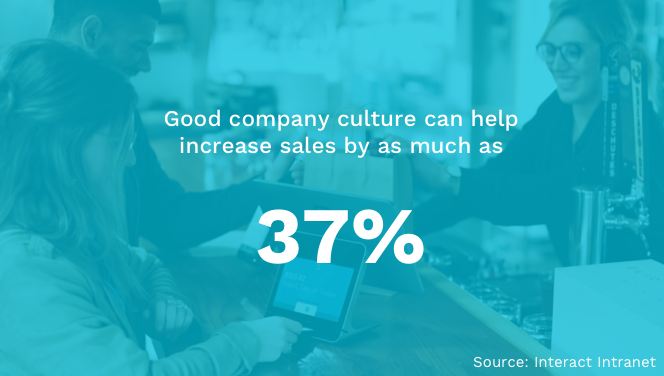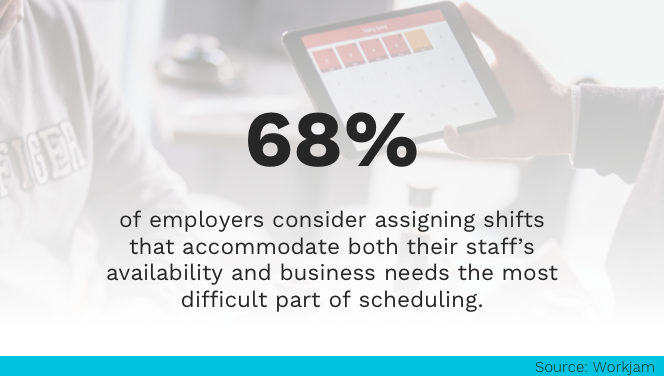Guest post by Chloe Sesta Jacobs
The national unemployment rate is at its lowest in 30 years. From its peak in 2009 at 10% to its current rate of around 3.6%, employers in all industries need to start getting competitive to retain good employees.
And how do you do that in retail?
The best way to bring in and keep hard workers is to make your store a great place to work. Using these steps, you can create a great culture that nurtures your employees.
What’s in?
1. Hire for the team, not the individual
The hiring process often focuses on the person sitting in front of you for an interview. One of the secret weapons for creating a great place to work is to hire with your other employees in mind. Yes, you may have someone with a great personality, lots of charisma, and just the right amount of experience. But, if that person clashes with your loyal employees or management team, then they can cause more damage than good.
While the national employee turnover rate is 15%, the retail turnover is at startling 60%. Many factors affect that rate, but among them are poor hiring decisions and employees leaving because of personnel issues.
Ask in-depth questions that will spark the retelling of an event. Use questions such as, “When have you argued with a coworker, or thought that they were wrong, and what did you do?” This can produce remarkable insight into their personality during a conflict.
To ‘hire for the team’ you need to have a good understanding of the people around you. Too many of the same personalities can lead to just as much fighting as people who are opposites. There is no “right” formula; a lot of evaluating how someone will fit in with your team is intuitive.

If you’re looking to get started, consider these steps:
- Have a clear image of your ideal workplace culture.
- Use a personality questionnaire as part of the hiring process.
- Have your current staff take reliable personality assessments (assessments supported by psychologists) such as ones based on the Big Five model or the DISC assessments.
- Have the candidates meet the team, for example, during a peer interview
When hiring, be sure to go beyond looking at the compatibility of the team. One of the top reasons that people quit retail positions is because of their supervisor. When hiring supervisors, it’s just as important to ask these questions.
While companies such as Target have used personality questionnaires for years, it’s still not very common. Often a business will opt for an integrity test over a personality questionnaire, but you can administer both. Hiring someone who will create dissonance in your team will make the entire workplace toxic in a short time frame.
2. Use technology to improve productivity
Finding out what technology is best for your store is a trial and error process. You can always go through and make a list of features that you would prefer to have available. You could also make a list of features that may seem overwhelming or unnecessary to your staff.
For example, a time clock system that has 11 different ways to get the time clock might seem efficient at first, but it would make training and consistent use of the technology difficult.
Technology should only exist in businesses to improve productivity. That often means you need a level of customization and a high degree of simplicity. Essentially, you need a POS system and a scheduling system.
Modern workforce management systems allow store managers to schedule retail staff based on not only their availability but also budget available, sales forecasts and other criteria, which saves both time and money. Some even have artificial intelligence implemented that predicts and suggests shift schedules based on all mentioned criteria in a matter of minutes.
Like what you see?
Don’t miss out. Subscribe to our quarterly digest to get the latest TA and TM resources delivered right to your inbox.
3. Break the mold on the “retail” experience
The belief is that the retail experience is a bunch of teenagers hanging around a register on their cell phones getting yelled at by their manager. Honestly, retail isn’t an after-school job anymore. 31% of retail workers are less than 24-years-old, meaning that more than 2/3 of the workforce is over 24.
People working in retail need the same benefits and workplace experience that any other working adult expects. Retail staff require access to healthcare, regular hours, and knowing their schedule more than a week in advance.
Consider offering these benefits:
- Provide lunch (or a snack) for your staff periodically
- Schedule in a way employees can plan events and vacations
- Offer wellness benefits by making a deal with a gym near your location
- Trade gift cards or rewards with other local shops to give away as rewards for good work
- Hand out awards for particular accomplishments
- Create the opportunity for continued development, promotions, pay increases, or similar.
You don’t need to change your retail store completely, but you can offer benefits and experiences that go beyond what other retails stores provide their staff.
4. Make your employees’ happiness a priority
Happy employees can be 20% more productive than unhappy staff, and boost sales by 37%. Making someone happy is much easier than it initially seems, but why is it so important to employers? Well, happy employees show up to work more often, get sick less often, do more work, and spread happiness.
30% of workers state that they would willingly work overtime or longer hours when they were happy. Additionally, 38% of employees say that they know their happiness affects their productivity.
You can start focusing on employee happiness by opening a dialogue. Talking about happiness does come with the risk of exposing many of your employees’ pain points. Areas where they’re unhappy and want changes that you may or may not be able to accommodate. Focus on compromises at first.
Consider these low-risk, high-reward activities that can spark joy:
- Allow employees to play their music after hours
- Break dull or widely hated routines when possible
- Encourage discussion about future goals
- Do good in the community with your employees
- Discuss what the last shift did well in huddles, rather than what went wrong
When you consider that most people spend time with their coworkers than their family, you might hesitate to stop a bit of chatter the next time you see people standing around waiting to start their shift.
- White paper
Before you continue!
Don’t forget to grab your free copy of our new white paper on the digital transformation of retail volume hiring. Learn about:
- The challenges currently shaping the retail volume hiring space
- How to align your recruitment strategy with today’s reality by adopting technology
- The four building blocks of a fully digital recruitment process

5. Improve scheduling and optimize shift length
The typical 9 to 5 with weekends off and enjoying the holidays isn’t an option for retail staff. Retail stores are busy during the times that people would rather not be working, and that can make for some general dissatisfaction.
What can you do? Test out these ideas:
- Reward a holiday or weekend day off during a team contest
- Accommodate school schedules and if possible, secondary jobs as well
- Create clear policies on schedules
- Post schedules on time
- Remain consistent with scheduling requests and time-off requests
Finally, consider adapting how employees can make requests and how you accommodate those requests. Make it easy to request days off and encourage staff to work fewer hours rather than missing the entire day. It’s a little more work for you, but the employees will enjoy not losing a whole day off their check. Again, keep in mind that these need to be consistent policies or practices, not one-off situations based on how a manager feels that day.

Also, 68% of companies communicate employee schedules via physical charts. Doing this digitally would improve the scheduling and also the employee experience, as both managers and employees would have access to their schedules at any time.
6. Have a real break area
Do away with dark and dusty rooms that are probably not sanitary for eating. Make a break area that’s comfortable, that isn’t the manager’s office, and give employees a real chance to rest.
There’s a lot of buzz going around about breaks and how managers feel about them. 22% of bosses in North America report that they believe that people who take regular lunch breaks don’t work as hard. Employees are feeling it too, with 38% of employees reporting that they’re not encouraged to take a break.
These stats show the difference between feelings and findings given the extensive studies done on how breaks create better employees. 81% of employees who took regular lunch breaks reported that they have a strong desire to be more active within their company.
Having an enjoyable break area and encouraging your staff to take regular breaks can have a substantial impact on their productivity and commitment to your store. Create a well-lit, clean, and comfortable to access breakroom.
7. Encourage constructive honesty
Honesty isn’t about saying what’s on your mind. It’s about presenting the situation with a facts first approach. Encourage employees and managers to communicate with a facts-focused mindset rather than criticizing based on their feelings.
Managers may choose to use mantras such as “Constructive conversations don’t start with ‘I feel’” or “Criticism isn’t constructive without proof.” But both can seem a little intense. So how can you promote constructive honesty without demanding the truth from every employee about each issue that arises?
Explore these options to encourage honesty and feedback:
Play the “Oh, fine” game. Ask everyone how their day is going and for each ‘fine’ assign a task that people would rather avoid. Not a chore, but something that isn’t necessarily fun. When people respond with a more specific answer, award them with a small prize or add a label on their name-tag that reads, “Better than fine.” The fun of this game is to promote honesty in small ways.
Teach your staff to listen actively. During a team huddle or meeting, ask someone to speak. Then, ask everyone else to remain quiet and hold all questions or comments until the end. Active listening is a large part of honesty because people are less inclined to skirt the truth when they know the other person is giving them their full attention. It also helps your team learn to identify when a story isn’t lining up.

Managers should provide a range of feedback and evaluation types to help employees thrive at their job. This can include formalized performance reviews but also infromal conversations.
8. Always take appropriate and consistent action
Consistency in handling employee performance and discipline isn’t a personal issue. It’s a legal risk. Many retails locations have the necessary policies in their handbook and then leave the rest to the manager on duty. Do away with that because it breeds an environment of resentment and favoritism. You’ll regularly get questions such as, “You don’t say anything when she’s late, why am I in trouble?”
The point is that you need to treat every employee the same. Put specific measures in place for everyday situations specifically for “he-said, she-said” issues.
When writing these policies, practices, or best practices, keep in mind that they need to be appropriate, fair, and representative of the company culture.
Consider possible best practices, such as:
- Time off requests must be submitted at least one week in advance (make reasonable exceptions for unforeseen life events such as funerals).
- Having a sick day or call-off day policy in place.
- Tardiness policies to combat consistent lateness.
- Three instances of disciplinary action for the same thing will lead to termination.
It would be best if you had an employee handbook to guide you and your management team through disciplinary action, time off requests, employee issues, and more.
9. Promote open communication
Along with constructive honesty, you need open communication. As the owner or manager, you need to know if someone is disrupting the team or creating a toxic environment that makes people not want to come into work. Offer the opportunity for anonymous reports, one-on-one meetings, and mediated group discussions.
Many managers are giving their staff the opportunity to email their concerns. That way, there’s documentation of the issue, and there’s not an awkward conversation. Another step to take is to gather all the information on an issue before starting the discussion. Take an investigative approach to complaints and concerns rather than listening to the problem and making an immediate judgment call.
10. Recognize your staff and your customers
Recognition is what employees want most. More than schedule flexibility or pay raises. Recognizing your staff is the act of making them want to work for you, without losing anything in return. Unfortunately, managers are often taught through their training to criticize, scold, and discipline rather than nurture and encourage.
Employee of the month might seem outdated, but you can still recognize your employees for specific occasions and accomplishments. Celebrate “workiversaries,” birthdays, and life achievements that happen outside of work (think graduations or making it through a rough personal time).
Don’t forget to give your staff the chance to incite some celebration too. Ask them to recognize customers that seem to be in a great mood, come in to shop frequently, or are polite to the cashier. Fun and silly recognition for the customers make the workplace better than the dull, “welcome to (insert store name)” mumble customers get when they walk in the door.
Over to you
These steps cover everything from hiring new employees to your employee’s daily activities. Don’t forget to look at your staff for inspiration too. What do your happy employees do that your other team doesn’t, and why are they happy at work? You can make your retail store a remarkable place to work and stand out from the competition.
That way, you will be able to attract and retain the best retail employees.
| About the Author: Chloe’s why is people; she gets her kicks from intensifying the purpose and exploring the potential of those around her. She works as Head of People & Culture & Culture at Deputy, a robust scheduling software that can be used to manage your workforce in a wide variety of different industries. Chloe sees her work as an extension of her lifestyle and is constantly working on revolutionising the people and culture space. |
- White paper
Before you continue!
Don’t forget to grab your free copy of our new white paper on the digital transformation of retail volume hiring. Learn about:
- The challenges currently shaping the retail volume hiring space
- How to align your recruitment strategy with today’s reality by adopting technology
- The four building blocks of a fully digital recruitment process



